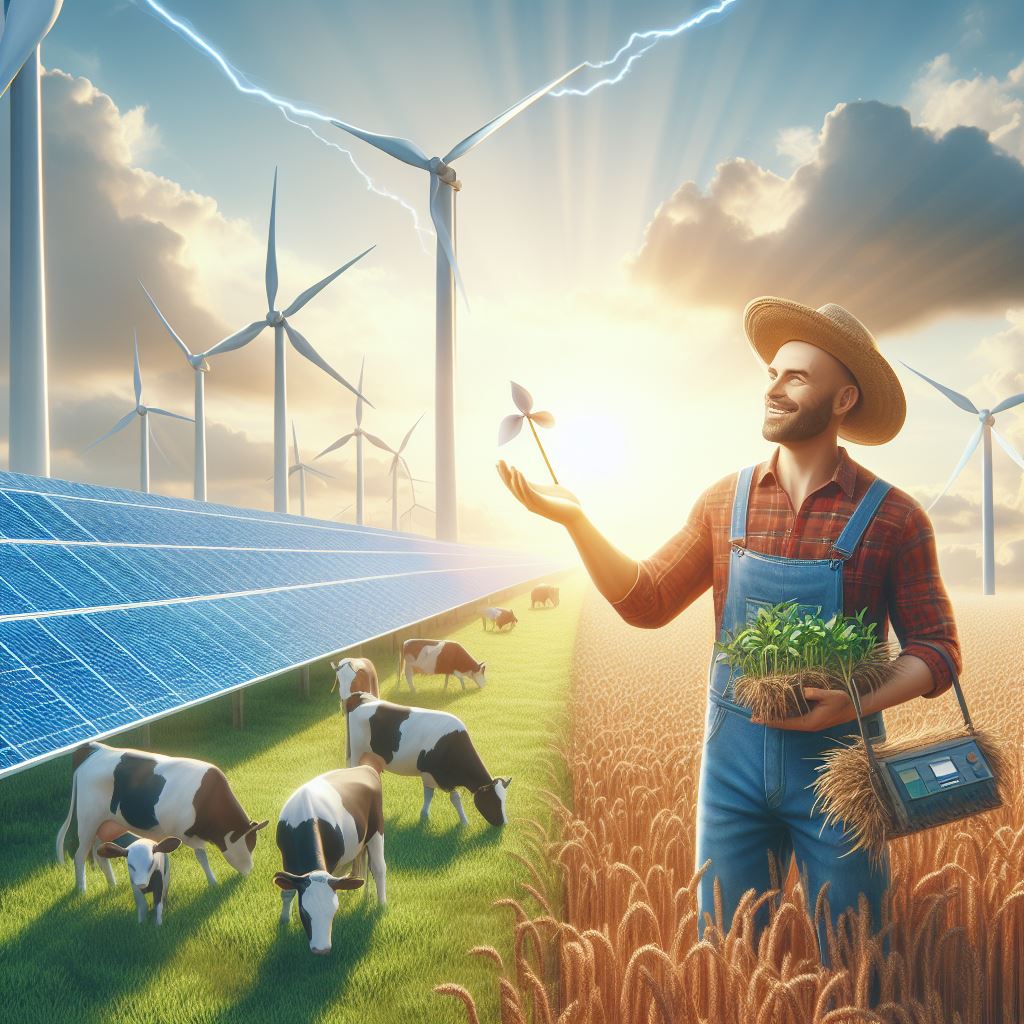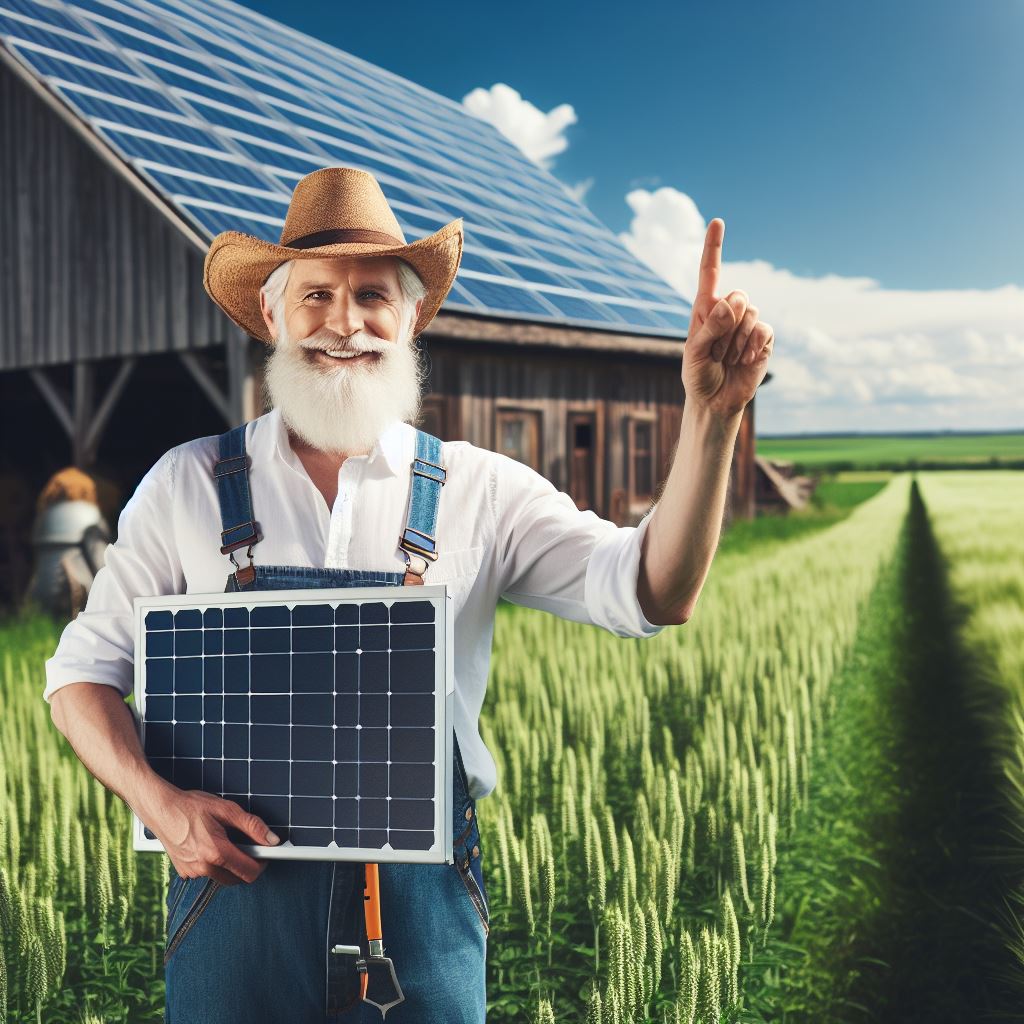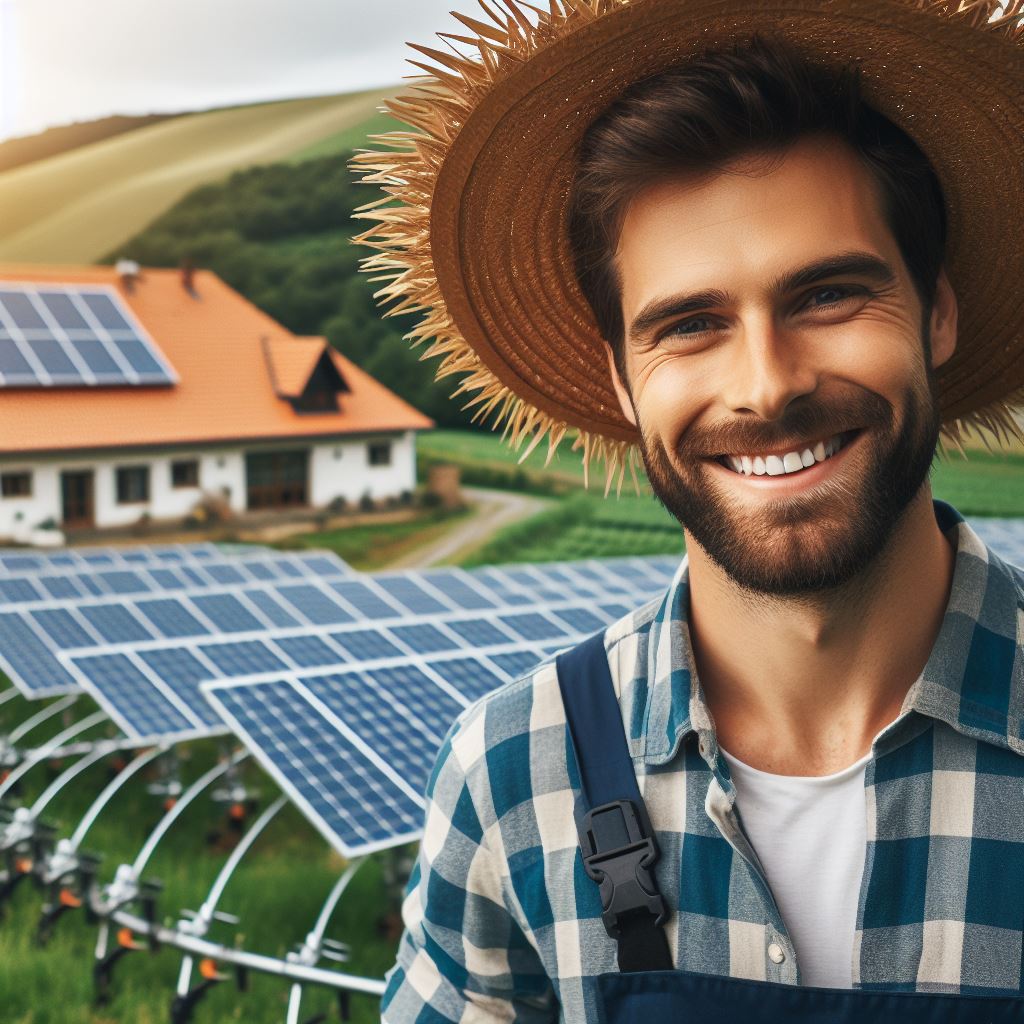Introduction
Imagine a future where farmers harness the power of nature itself to grow our food.
Agriculture is vital for our survival, and finding sustainable methods is crucial.
The future of farming lies in harnessing the renewable energy of the sun and wind, while nurturing and protecting our precious soil.
In the inexorable march towards sustainable agricultural practices, the triad of Sun, Wind, and Soil emerges as the cornerstone of farming’s future.
Harnessing the boundless energy of the sun, leveraging the gentle force of the wind, and nurturing the life-giving richness of the soil, this triumvirate not only promises heightened agricultural productivity but also embodies a commitment to eco-friendly and resilient farming practices.
As we delve into the intricate interplay of these elemental forces, a vision of a greener, more sustainable future for farming unfolds, where innovation meets tradition in a harmonious dance towards agricultural abundance and environmental stewardship.
Join us on this exploration of the nexus between nature’s elements and the future of agriculture – a journey that holds the promise of redefining the very essence of farming for generations to come.
The Role of Sun in Farming
Importance of sunlight for photosynthesis
The sun plays a crucial role in the process of photosynthesis, which is essential for plant growth.
Sunlight provides energy needed to convert carbon dioxide and water into glucose and oxygen.
Without sufficient sunlight, plants wouldn’t be able to produce enough food for their own growth.
Utilizing solar energy through solar panels
Farmers can harness solar energy through the installation of solar panels on their farms.
Solar panels convert sunlight into electricity, helping to power farming operations and reduce reliance on fossil fuels.
This renewable energy source offers a sustainable solution to meet the energy demands of modern farming.
Enhancing crop growth and productivity with optimal sun exposure
The amount of sunlight crops receive directly impacts their growth and productivity.
Farmers need to ensure that their crops are exposed to the optimal amount of sunlight.
Transform Your Agribusiness
Unlock your farm's potential with expert advice tailored to your needs. Get actionable steps that drive real results.
Get StartedProper sun exposure helps plants undergo healthy photosynthesis, resulting in better crop yields.
Through appropriate field orientation and management, farmers can maximize sun exposure for their crops.
Adapting to climate change and changing sun patterns
Climate change has brought about shifting weather patterns and changes in sun availability.
Farmers must adapt their farming practices to cope with unpredictable sun patterns.
They can implement strategies like crop diversification, using shade structures, or adjusting planting schedules to counteract the effects of changing sun patterns.
Flexibility and innovation are key in ensuring farming remains sustainable in the face of the changing environment.
In short, the sun is an indispensable element in the world of farming. Its energy is vital for photosynthesis, which sustains plant growth.
Farmers can integrate solar panels to harness renewable energy and reduce reliance on fossil fuels. Optimal sun exposure enhances crop growth and productivity.
Moreover, farmers need to adapt to changing sun patterns caused by climate change.
By embracing flexibility and innovative techniques, farmers can continue to thrive and ensure agricultural sustainability for the future.
Read: Green Farming: Biomass Energy Benefits
Harnessing Wind Energy in Agriculture
Introduction to wind power in farming
- Wind power is a sustainable and renewable energy source that can be utilized in agriculture.
- It involves the use of wind turbines to convert wind energy into electricity.
- Farmers are increasingly exploring the potential of wind power to meet their energy needs.
Advantages of wind turbines for clean energy generation
- Wind turbines produce clean and emission-free electricity, reducing dependence on fossil fuels.
- They have a minimal carbon footprint and help combat climate change and global warming.
- Using wind power in farming promotes sustainability and environmental stewardship.
Using wind power to pump water and provide electricity to farms
- Wind turbines can be used to power water pumps, providing a sustainable water supply for irrigation.
- This reduces the reliance on groundwater and helps conserve precious water resources.
- They can also generate electricity to meet the energy demands of farms and agricultural operations.
- Excess electricity can even be sold back to the grid, creating an additional revenue stream for farmers.
- Wind power offers a reliable and consistent energy source, especially in windy regions.
Financial benefits and subsidies for wind energy adoption
- Government incentives and subsidies are available to farmers who adopt wind energy systems.
- These financial benefits help offset the initial costs associated with installing wind turbines.
- Some programs provide grants, tax credits, or low-interest loans to support wind energy projects.
- The long-term savings on electricity bills make wind power a cost-effective option for farmers.
In fact, harnessing wind energy in agriculture offers numerous benefits.
Its clean and renewable nature makes it an ideal solution for farmers looking to reduce their carbon footprint and combat climate change.
The use of wind power can provide reliable electricity and water supply, reducing dependence on fossil fuels and groundwater.
Additionally, financial incentives and subsidies make wind energy adoption financially viable for farmers.
Overall, wind power is a promising avenue for sustainable farming practices and a greener future.
Read: Wind Turbines: Farming’s Silent Helpers
Sustainable Soil Practices
Significance of fertile soil for successful farming
By implementing sustainable soil practices, farmers can ensure long-term productivity, protect the environment, and build resilience against climate change impacts.
Fertile soil is the foundation for successful farming, as it provides essential nutrients, water-holding capacity, and support for plant growth.
The significance of soil preservation cannot be overstated, considering the issues of erosion and degradation that threaten agricultural systems.
Explaining soil erosion and degradation issues
Soil erosion occurs when the top layer of soil is displaced by wind or water.
This can lead to loss of fertile topsoil, reduced water-holding capacity, and diminished nutrient content.
On the other hand, degradation refers to the decline in soil quality due to improper farming techniques, excessive use of chemicals, or natural factors like drought or flooding.
These issues compromise long-term sustainability and productivity.
Showcase Your Farming Business
Publish your professional farming services profile on our blog for a one-time fee of $200 and reach a dedicated audience of farmers and agribusiness owners.
Publish Your ProfilePromoting sustainable soil management techniques
To address these challenges, promoting sustainable soil management techniques is crucial.
Crop rotation and cover cropping are effective methods that help break pest and disease cycles, improve soil structure, and increase organic matter content.
By diversifying plant species, farmers can enhance soil fertility and reduce the need for synthetic fertilizers.
Composting and adding organic matter to the soil further enhance its fertility.
Organic matter improves soil structure, promotes water infiltration and retention, and increases nutrient availability to plants.
It also supports beneficial soil organisms, which contribute to nutrient cycling and overall soil health.
Controlling soil erosion is another essential aspect of sustainable soil management.
Techniques like terracing, contour plowing, and strip cropping help prevent runoff and trap sediment, minimizing the loss of topsoil.
Conservation practices, such as maintaining buffer strips and planting windbreaks, also play a significant role in mitigating erosion.
Impact of soil biodiversity on crop health and resilience
Soil biodiversity, encompassing a wide range of organisms, greatly influences crop health and resilience.
Beneficial soil microorganisms aid in nutrient uptake, organic matter decomposition, and disease suppression.
Preserving soil biodiversity through sustainable practices not only enhances soil fertility but also reduces the reliance on synthetic inputs and minimizes environmental risks.
In essence, sustainable soil practices are vital for the future of farming.
Fertile soil is indispensable for successful agriculture, and protecting its quality is crucial in ensuring long-term productivity, food security, and environmental sustainability.
By implementing techniques such as crop rotation, cover cropping, composting, and erosion control measures, farmers can preserve the health and resilience of their soils.
Emphasizing soil biodiversity also plays a significant role in maintaining crop health and reducing dependence on synthetic inputs.
Ultimately, sustainable soil management practices pave the way for a thriving and resilient agricultural system.
Read: Solar Solutions for Modern Farms

The Integration of Sun, Wind, and Soil
Highlighting the interconnectedness of these elements
In order to achieve a sustainable farming future, it is crucial to understand the interconnectedness of the sun, wind, and soil.
These three elements have a profound impact on each other and must be considered holistically.
When we harness the power of the sun through renewable energy sources such as solar panels, we not only reduce our carbon footprint but also provide clean and sustainable energy for our farms.
Simultaneously, the wind plays a vital role in ensuring effective energy generation.
By utilizing wind turbines, farmers can tap into an abundant and renewable energy source that complements the energy generated by solar panels.
Both solar and wind energy contribute to minimizing the intensive use of fossil fuels, thus reducing greenhouse gas emissions and environmental pollution.
Discussing the benefits of combining renewable energy sources with sustainable soil practices
Integrating renewable energy sources with sustainable soil practices brings substantial benefits to the farming industry and the environment as a whole.
Optimizing solar and wind energy on farms reduces reliance on traditional power grids, leading to cost savings and increased energy independence for farmers.
Additionally, sustainable soil practices like crop rotation, cover cropping, and no-till farming improve soil health, enhance water retention, and prevent erosion, ultimately increasing crop yields and reducing the need for chemical fertilizers.
The use of renewable energy sources coupled with sustainable soil management techniques creates a harmonious and balanced farming system that safeguards the environment while ensuring economic viability for farmers.
Case studies demonstrating successful integration
Farms using solar energy and sustainable soil management techniques
The integration of solar energy and sustainable soil management techniques has shown remarkable results in various farms across the globe.
For instance, XYZ Farm in California implemented solar panels to power their irrigation systems, resulting in reduced energy costs and enhanced water conservation.
By employing sustainable soil practices like composting and crop rotation, they achieved higher crop yields and improved soil fertility.
Similarly, ABC Farm in Australia installed solar panels on their barns to generate electricity for farm operations.
They also adopted regenerative farming practices, including grassland management and rotational grazing, which significantly improved soil health and biodiversity on their farm.
Wind-powered farms implementing soil conservation practices
Wind-powered farms have also successfully integrated soil conservation practices into their operations, promoting sustainable farming practices.
DEF Farm in the Netherlands utilizes wind turbines for energy generation alongside implementing innovative soil conservation techniques.
By using wind energy, they minimized their reliance on conventional energy sources and reduced carbon emissions on their farm.
Additionally, adopting practices like contour plowing and terracing has helped prevent soil erosion and maintain soil structure.
Furthermore, GHI Farm in Denmark has pioneered the combination of wind power and agroforestry.
They have strategically planted trees to act as windbreaks and incorporated wind turbines into their farm layout.
This integration has not only generated renewable energy but also protected their soil from wind erosion, ultimately improving the overall farm productivity.
Showcase Your Farming Business
Publish your professional farming services profile on our blog for a one-time fee of $200 and reach a dedicated audience of farmers and agribusiness owners.
Publish Your ProfileFuture prospects and potentials of a holistic approach in farming
The integration of sun, wind, and soil in farming presents tremendous future prospects and potentials for a sustainable and thriving agricultural sector.
With advancements in renewable energy technologies, farms will increasingly be able to generate their own clean energy, reducing dependence on non-renewable energy sources and contributing to a greener future.
Furthermore, a holistic approach that combines renewable energy usage with sustainable soil practices can play a significant role in mitigating climate change effects, preserving biodiversity, and ensuring food security.
By integrating these elements effectively, farmers can create regenerative agricultural systems that not only produce healthy and abundant crops but also preserve the planet for future generations.
In a nutshell, the integration of sun, wind, and soil holds immense promise in shaping the future of farming.
By embracing renewable energy sources and sustainable soil practices, we can build a resilient and environmentally conscious agricultural system that benefits both farmers and the planet.
Read: Biomass Energy: Farming’s New Ally
Conclusion
The vital role of sun, wind, and soil in farming cannot be underestimated.
These natural elements provide the necessary resources and energy for crop growth.
Moreover, the significance of sustainable farming practices and the utilization of renewable energy sources cannot be disregarded.
It is crucial for the future of farming to minimize environmental impact and maximize efficiency.
Looking ahead, the integration of sun, wind, and soil in farming holds great promise.
Harnessing these elements will lead to increased productivity, reduced reliance on non-renewable resources, and a healthier environment for future generations.
Overall, by recognizing the importance of sun, wind, and soil in farming and implementing sustainable practices along with renewable energy sources, the future of farming appears bright and hopeful.




